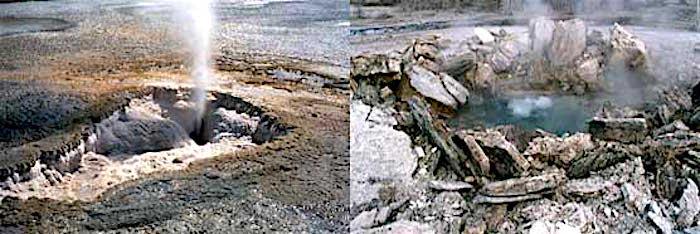
The Norris Geyser Basin is beautiful...and dangerous/Kurt Repanshek file photo
An Oregon man who died when he fell into a thermal feature in Yellowstone National Park just wanted to "dip his toe into the hot spring," according to his sister.
Colin Nathaniel Scott, 23, and his sister, Sable, had wandered nearly 700 feet off a boardwalk in the Back Basin of the Norris Geyser Basin on Tuesday afternoon. Not far from Porkchop Geyser, a thermal feature that once simmered as a hot spring before launching into a continuous series of surging spouts in 1985, the two neared a small, unnamed hot spring.
"As he approached the hot spring, we had heard that he was going to, or was attempting to, dip his toe into the hot spring, and he slipped or fell into it," Yellowstone spokeswoman Morgan Warthin told the Traveler on Thursday. "With regards to the hot spring itself ... the subsurface temperatures in the spring are super-heated, and it has a pH of close to 4. What that means is that it has a very high acidity.”

Porkchop Geyser in the Norris Geyser Basin/NPS
Yellowstone can be a wild and dangerous place. While grizzly bears certainly pose a threat to backcountry travelers who aren't careful, and bison and elk pose a front-country threat, "...hot springs deaths have ocurred much more commonly in Yellowstone National Park than have grizzly bear deaths," Yellowstone historian Lee Whittlesey writes in his book, Death In Yellowstone, Accidents and Foolhardiness in the First National Park.
While there are thermal features throughout most of the 2.2-million-acre park that fills the northwest corner of Wyoming and spills over a bit into Montana and Idaho, those in the Norris Geyser Basin, the park's oldest thermal basin, are the hottest and most colorful. This is where Steamboat, which boasts the tallest geyser eruption in the world, is found. Visitors can explore the basin via a two-and-a-quarter-mile-long boardwalk that winds through it. Signs along the way remind visitors that it's illegal, and dangerous, to leave the boardwalk, in part because of the thin surface crust that in places can break under an individual's weight and plunge them into scalding, acidic waters.

The young man fell into a hot spring in the Back Basin area of the Norris Geyser Basin/Map via National Park Maps, www.npmaps.com
The spring that Mr. Scott tumbled into simmers right around 199 degrees Fahrenheit (~93 C). His death was nearly instantaneous, and by the time rangers could respond there were no remains visible to recover, said Ms. Warthin.
Another park spokeswoman, Charissa Reid, said a helicopter was used to provide rangers with a closeup view of the hot spring, and Geographic Information System thermal imaging maps were used to pinpoint the hottest areas of the ground between the boardwalk and the hot spring so rangers could safely approach the spring.
"Two members of the GIS team that were very familiar with the Norris Geyser Basin served as technical experts and directed recovery teams as they moved through the basin," she said.
Whether Porkchop Geyser, or other thermal features, will be affected by the man's remains is hard to say, according to Ms. Reid.
"The features here are really interconnected," she said. "We just don’t know enough about that area to make any speculative guess about what might happen.”



Comments
Ouch.
i was at Yellowstone last year and I was amazed at the number of people who went off trail. It wasn't only at this park, however, but at several others as well.
No one ever said the human condition was without stupidity. We too traveled to a number of national parks (22) this past fall and it never ceased to amaze us the number of times we saw tourists engaged in stupid, if not life threatening, activities, especially around wildlife. People, it's called "wildlife" for a reason...respect it. Also, signs warning you to not go off pathways/trails aren't there to spoil your "fun," no, generally, as with this young man, they are there to try and spare you a significant injury or your life. Is your ignoring them worth either?
I have been to the Park 9 times. I have seen disturbing behavior many times like rocks being thrown into a thermal pool, people getting to close to bison. People petting a elk. Walking off the boardwalks. If you are not willing to abide by the rules and respect the Park, please do not go. This is not Disneyland. If you want great pictures of the wildlife, leave your camara phone in the car and instead go to one of the many book stores in the Park, and Buy them! Think about what you doing at all times, your life may depend on it.
I don't get how he couldn't get out of the hole?
The incedent report is online but every part around him falling in has been redacted.
Why? What's the big secret? I mean, maybe if people knew the reason he couldn't crawl out
of it then it might avoide else trying this in the future, right?
They said it was muddy but the photos I've seen look like, even if the water was
boiling, you still should have been able to crawl out of it.
You're not crawling or swimming out of 200 degree F acid.
I read the report. And like the person above me stated, it was heavily redacted. And I agree, while the details may be extremely gruesome...I feel if more people were to know and fully understand the danger thermal features pose, it'll steer them clear from wandering off the path.
While foolhardy..I feel bad for the poor sister. Seeing her beloved brother melting before her very eyes AND, capturing his demise on her cellphone. That's going to take years and years of therapy to undo that mental trauma.